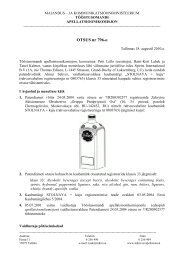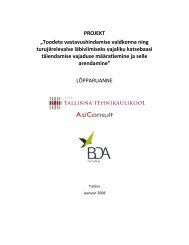Feasibility study for an Estonian Materials Technology Programme
Feasibility study for an Estonian Materials Technology Programme
Feasibility study for an Estonian Materials Technology Programme
Create successful ePaper yourself
Turn your PDF publications into a flip-book with our unique Google optimized e-Paper software.
36<br />
<strong>Feasibility</strong> <strong>study</strong> <strong>for</strong> <strong>an</strong> Estoni<strong>an</strong> <strong>Materials</strong> <strong>Technology</strong> <strong>Programme</strong><br />
2. <strong>Materials</strong> technology in Estonia<br />
2.4.3 Chemical industry<br />
Industry overview<br />
The chemical industry in Estonia accounts <strong>for</strong> approximately 1% of all sales revenues of the economy <strong>an</strong>d a<br />
little over 5% of the m<strong>an</strong>ufacturing industry (5.3% or 5B EEK in 2009). The industry is there<strong>for</strong>e similar in size<br />
compared e.g. to the plastics industry. 32 The chemical industry consists of two import<strong>an</strong>t subsectors that are<br />
oil shale chemistry <strong>an</strong>d rare earth metals <strong>an</strong>d oxides production. The industry is very export oriented as 85% of<br />
the production is exported. Oil shale exports made up 1.7% of the country’s exports in 2009.<br />
According to the Federation of Estoni<strong>an</strong> Chemical Industries, there have been a lot of ef<strong>for</strong>ts in recent years to<br />
improve the efficiency <strong>an</strong>d environmental friendliness of the industry. However, the federation states that the<br />
development should still continue <strong>an</strong>d needs more fin<strong>an</strong>cial capital, skilled labour <strong>an</strong>d product development to<br />
succeed.<br />
The majority of Estoni<strong>an</strong> chemical industry related to materials technology is closely linked to construction<br />
materials, including comp<strong>an</strong>ies such as Henkel Makroflex, Krimelte, Akzo Nobel, ES Sadolin, Tikkurila <strong>an</strong>d<br />
Eskaro. The oil shale production is somewhat related to materials technologies as some university research<br />
groups are <strong>study</strong>ing the utilisation of oil shale waste <strong>an</strong>d fly ash <strong>for</strong> construction materials production. Major<br />
comp<strong>an</strong>ies involved in oil shale production in Estonia include Eesti Energia Õlitööstus, VKG Oil <strong>an</strong>d Kiviõli<br />
Keemiatööstus. <strong>Materials</strong> technology is not, however, a core business of these comp<strong>an</strong>ies <strong>an</strong>d there<strong>for</strong>e, it is<br />
unlikely that they would be willing to invest heavily in the development of the field.<br />
A single comp<strong>an</strong>y with relatively high import<strong>an</strong>ce <strong>for</strong> the country is Silmet, which has a unique position in the<br />
whole Europe being one of the largest rare earth metals <strong>an</strong>d oxides producers. The metals are of high strategic<br />
import<strong>an</strong>ce globally as they are needed in various high technology applications <strong>an</strong>d are difficult or impossible<br />
to replace by other me<strong>an</strong>s. Some large comp<strong>an</strong>ies also exist in agricultural chemical <strong>an</strong>d fertiliser production<br />
including Baltic Agro, Farm Pl<strong>an</strong>t Eesti, Agrochema Eesti <strong>an</strong>d Nitrofert.<br />
Chemical industry has undoubtedly a key role in developing materials technologies in Estonia. It corresponds<br />
to a very large share of total production of the economy, it is very export intensive <strong>an</strong>d chemistry is widely<br />
taught at Estoni<strong>an</strong> universities. Still, the role of chemical industry in Estonia is relatively small when compared<br />
to the rest of Europe as the Europe<strong>an</strong> chemical industry has traditionally produced twice as much chemicals as<br />
it consumes. This is a completely opposite case in Estonia, as the country consumes twice as much chemicals<br />
as it produces.<br />
Un<strong>for</strong>tunately <strong>for</strong> Estonia, its chemical industry is very much SME oriented: 85% of the member comp<strong>an</strong>ies<br />
of the Federation of Estoni<strong>an</strong> Chemical Industries are SMEs (2009) <strong>an</strong>d there are only 6 comp<strong>an</strong>ies employing<br />
more th<strong>an</strong> 100 people <strong>an</strong>d 5 comp<strong>an</strong>ies employing 50-99 people. In the chemical industry, larger comp<strong>an</strong>ies<br />
have a natural cost adv<strong>an</strong>tage gained from high volume production <strong>an</strong>d there<strong>for</strong>e increasing competitiveness<br />
of the industry requires very large investments. The REACH regulations are also a tough challenge <strong>for</strong> Estoni<strong>an</strong><br />
chemical industry because comp<strong>an</strong>ies need to register their products, which costs a signific<strong>an</strong>t amount of<br />
money <strong>an</strong>d requires <strong>an</strong> extensive amount of work. There is currently a lack of know-how in both comp<strong>an</strong>ies<br />
<strong>an</strong>d public sector <strong>an</strong>d there<strong>for</strong>e, the country needs to rely on <strong>for</strong>eign expertise regarding the REACH regulation.<br />
R&D <strong>an</strong>d education<br />
Chemistry is widely taught at Estoni<strong>an</strong> universities. Main contributors include Tartu University, Institute of<br />
Chemistry <strong>an</strong>d Tallinn University of <strong>Technology</strong>, Faculty of Chemical <strong>an</strong>d <strong>Materials</strong> <strong>Technology</strong>. Other notable<br />
players include Faculty of Science at Tallinn University of <strong>Technology</strong>, Institute of <strong>Technology</strong> in Tartu University<br />
<strong>an</strong>d Institute of Mathematics <strong>an</strong>d Natural Sciences at Tallinn University. The National Institute of Chemical<br />
Physics <strong>an</strong>d Biophysics is conducting research in chemistry. The areas of chemistry education <strong>an</strong>d research<br />
include: Chemical engineering (TUT), Environmental Chemistry (TUT, TU, KBFI), Analytical Chemistry (TUT, TU),<br />
Inorg<strong>an</strong>ic Chemistry (TUT, TU), Bioorg<strong>an</strong>ic chemistry (TUT, TU, KBFI), Biotechnology (TUT), Molecular technology<br />
(TUT, TU), Org<strong>an</strong>ic chemistry (TUT, TU), <strong>Materials</strong> chemistry (TUT, TU), Electrochemistry (TU) <strong>an</strong>d Physical<br />
chemistry (TU, TUT).<br />
32 www.keemia.ee





